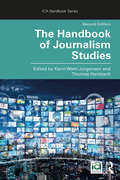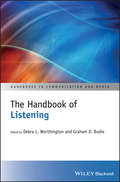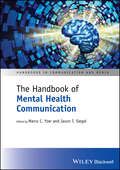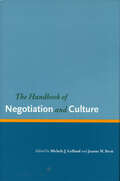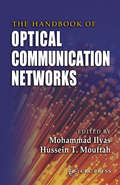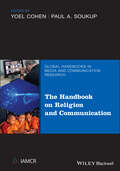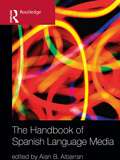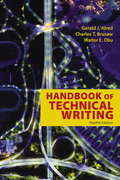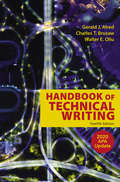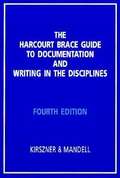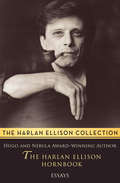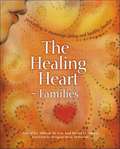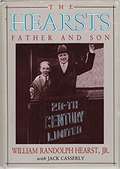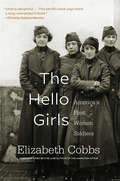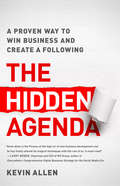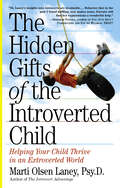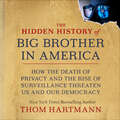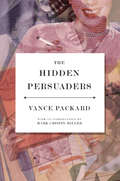- Table View
- List View
The Handbook of Journal Publishing
by Margaret Reich Sally Morris Ed Barnas Douglas LafrenierThe Handbook of Journal Publishing is a comprehensive reference work written by experienced professionals, covering all aspects of journal publishing, both online and in print. Journals are crucial to scholarly communication, but changes in recent years in the way journals are produced, financed, and used make this an especially turbulent and challenging time for journal publishers - and for authors, readers, and librarians. The Handbook offers a thorough guide to the journal publishing process, from editing and production through marketing, sales, and fulfilment, with chapters on management, finances, metrics, copyright, and ethical issues. It provides a wealth of practical tools, including checklists, sample documents, worked examples, alternative scenarios, and extensive lists of resources, which readers can use in their day-to-day work. Between them, the authors have been involved in every aspect of journal publishing over several decades and bring to the text their experience working for a wide range of publishers in both the not-for-profit and commercial sectors.
The Handbook of Journalism Studies (ICA Handbook Series)
by Karin Wahl-Jorgensen Thomas HanitzschThis second edition of The Handbook of Journalism Studies explores the current state of research in journalism studies and sets an agenda for future development of the field in an international context. The volume is structured around theoretical and empirical approaches to journalism research and covers scholarship on news production; news content; journalism and society; journalism and culture; and journalism studies in a global context. As journalism studies has become richer and more diverse as a field of study, the second edition reflects both the growing diversity of the field, and the ways in which journalism itself has undergone rapid change in recent years. Emphasizing comparative and global perspectives, this new edition explores: Key elements, thinkers, and texts Historical context Current state of the field Methodological issues Merits and advantages of the approach/area of study Limitations and critical issues of the approach/area of study Directions for future research Offering broad international coverage from world-leading contributors, this volume is a comprehensive resource for theory and scholarship in journalism studies. As such, it is a must-have resource for scholars and graduate students working in journalism, media studies, and communication around the globe.
The Handbook of Listening: Methodology And Measures (Handbooks in Communication and Media)
by Debra L. Worthington Graham D. BodieThe Handbook of Listening is a comprehensive overview of the field of listening for advanced undergraduate students, graduate students, scholars, and practitioners. First comprehensive academic reference resource dedicated to listening Provides a broad, authoritative, cross-disciplinary overview of key methodological, conceptual, and theoretical issues in the field Covers methods; disciplinary foundations; teaching listening; contexts and applications; and emerging perspectives Original chapters written by a group of international scholars in the field of learning
The Handbook of Mental Health Communication
by Jason T. Siegel Marco C. YzerThe first book of its kind to offer a transdisciplinary exploration of mass communication approaches to mental health In the Handbook of Mental Health Communication, a panel of leading scholars from multiple disciplines presents a comprehensive overview of theory and research at the intersection of mass communication and mental health. With timely and authoritative coverage of the impact of message-based mental health promotion, this unique volume places mental health communication in the context of socio-cultural causes of mental illness — synthesizing public health, psychopathology, and mass communication scholarship into a single volume. Throughout the Handbook, nearly one hundred contributing authors emphasize that understanding communication effects on mental health outcomes begins with recognizing how people across the spectrum of mental illness process relevant information about their own mental health. Fully integrated chapters collectively translate biased information attention, interpretation, and memory in mental health illness to real-world implications of mental illness symptomatology and across the spectrum of mental health issues and disorders. Providing a clear, evidence-based picture of what mental health promotion should look like, The Handbook of Mental Health Communication is an invaluable resource for advanced undergraduate and graduate students, scholars, researchers, lecturers, and all health communication practitioners.
The Handbook of Negotiation and Culture
by Michele J. GelfandIn the global marketplace, negotiation frequently takes place across cultural boundaries, yet negotiation theory has traditionally been grounded in Western culture. This book, which provides an in-depth review of the field of negotiation theory, expands current thinking to include cross-cultural perspectives. The contents of the book reflect the diversity of negotiation—research-negotiator cognition, motivation, emotion, communication, power and disputing, intergroup relationships, third parties, justice, technology, and social dilemmas—and provides new insight into negotiation theory, questioning assumptions, expanding constructs, and identifying limits not apparent from working exclusively within one culture. The book is organized in three sections and pairs chapters on negotiation theory with chapters on culture. The first part emphasizes psychological processes—cognition, motivation, and emotion. Part II examines the negotiation process. The third part emphasizes the social context of negotiation. A final chapter synthesizes the main themes of the book to illustrate how scholars and practitioners can capitalize on the synergy between culture and negotiation research.
The Handbook of Optical Communication Networks
by Hussein T. Mouftah Mohammad IlyasThe Internet revolution. Once, the public was delighted with 14.4 modem access and fascinated by low-tech Web site content. But not for long. Technology has raced to keep up with users' calls for high-speed facilities and advanced applications. With the development of high-speed transmission media and the availability of high-speed hardware, we are
The Handbook of Organizational Rhetoric and Communication (Handbooks in Communication and Media)
by Yvind Ihlen X00D8 Robert L HeathA one-stop source for scholars and advanced students who want to get the latest and best overview and discussion of how organizations use rhetoric While the disciplinary study of rhetoric is alive and well, there has been curiously little specific interest in the rhetoric of organizations. This book seeks to remedy that omission. It presents a research collection created by the insights of leading scholars on rhetoric and organizations while discussing state-of-the-art insights from disciplines that have and will continue to use rhetoric. Beginning with an introduction to the topic, The Handbook of Organizational Rhetoric and Communication offers coverage of the foundations and macro-contexts of rhetoric—as well as its use in organizational communication, public relations, marketing, management and organization theory. It then looks at intellectual and moral foundations without which rhetoric could not have occurred, discussing key concepts in rhetorical theory. The book then goes on to analyze the processes of rhetoric and the challenges and strategies involved. A section is also devoted to discussing rhetorical areas or genres—namely contextual application of rhetoric and the challenges that arise, such as strategic issues for management and corporate social responsibility. The final part seeks to answer questions about the book’s contribution to the understanding of organizational rhetoric. It also examines what perspectives are lacking, and what the future might hold for the study of organizational rhetoric. Examines the advantages and perils of organizations that seek to project their voices in order to shape society to their benefits Contains chapters working in the tradition of rhetorical criticism that ask whether organizations’ rhetorical strategies have fulfilled their organizational and societal value Discusses the importance of obvious, traditional, nuanced, and critically valued strategies such as rhetorical interaction in ways that benefit discourse Explores the potential, risks, paradoxes, and requirements of engagement Reflects the views of a team of scholars from across the globe Features contributions from organization-centered fields such as organizational communication, public relations, marketing, management, and organization theory The Handbook of Organizational Rhetoric and Communication will be an ideal resource for advanced undergraduate students, graduate students, and scholars studying organizational communications, public relations, management, and rhetoric.
The Handbook of Public Sector Communication (Handbooks in Communication and Media #91)
by Vilma Luoma-Aho María‐José CanelA multidisciplinary collection on global public entity strategic communication Research into public sector communication investigates the interaction between public and governmental entities and citizens within their sphere of influence. Today’s public sector organizations are operating in environments where people receive their information from multiple sources. Although modern research demonstrates the immense impact public entities have on democracy and societal welfare, communication in this context is often overlooked. Public sector organizations need to develop “communicative intelligence” in balancing their institutional agendas and aims of public engagement. The Handbook of Public Sector Communication is the first comprehensive volume to explore the field. This timely, innovative volume examines the societal role, environment, goals, practices, and development of public sector strategic communication. International in scope, this handbook describes and analyzes the contexts, policies, issues, and questions that shape public sector communication. An interdisciplinary team of leading experts discusses diverse subjects of rising importance to public sector, government, and political communication. Topics include social exchange relationships, crisis communication, citizen expectations, measuring and evaluating media, diversity and inclusion, and more. Providing current research and global perspectives, this important resource: Addresses the questions public sector communicators face today Summarizes the current state of public sector communication worldwide Clarifies contemporary trends and practices including mediatization, citizen engagement, and change and expectation management Addresses global challenges and crises such as corruption and bureaucratic roadblocks Provides a framework for measuring communication effectiveness Requiring minimal prior knowledge of the field, The Handbook of Public Sector Communication is a valuable tool for academics, students, and practitioners in areas of public administration, public management, political communication, strategic and organizational communication, and related fields such as political science, sociology, marketing, journalism, and globalization studies.
The Handbook of Religion and Communication (Global Handbooks in Media and Communication Research)
by Yoel Cohen Paul A. SoukupProvides a contemporary view of the intertwined relationship of communication and religion The Handbook on Religion and Communication presents a detailed investigation of the complex interaction between media and religion, offering diverse perspectives on how both traditional and new media sources continue to impact religious belief and practice across multiple faiths around the globe. Contributions from leading international scholars address key themes such as the changing role of religious authority in the digital age, the role of media in cultural shifts away from religious institutions, and the ways modern technologies have transformed how religion is communicated and portrayed. Divided into five parts, the Handbook opens with a state-of-the-art overview of the subject’s intellectual landscape, introducing the historical background, theoretical foundations, and major academic approaches to communication, media, and religion. Subsequent sections focus on institutional and functional perspectives, theological and cultural approaches, and new approaches in digital technologies. The essays provide insight into a wide range of topics, including religious use of media, religious identity, audience gratification, religious broadcasting, religious content in entertainment, films and religion, news reporting about religion, race and gender, the sex-religion matrix, religious crisis communication, public relations and advertising, televangelism, pastoral ministry, death and the media, online religion, future directions in religious communication, and more. Explores the increasing role of media in creating religious identity and communicating religious experience Discusses the development and evolution of the communication practices of various religious bodies Covers all major media sources including radio, television, film, press, digital online content, and social media platforms Presents key empirical research, real-world case studies, and illustrative examples throughout Encompasses a variety of perspectives, including individual and institutional actors, academic and theoretical areas, and different forms of communication media Explores media and religion in Judeo-Christian traditions, Islam, Buddhism, Hinduism, religions of Africa, Atheism, and others The Handbook on Religion and Communication is an essential resource for scholars, academic researchers, practical theologians, seminarians, mass communication researchers, and undergraduate and graduate students taking courses on media and religion.
The Handbook of Spanish Language Media
by Alan AlbarranWith the rise of Spanish language media around the world, The Handbook of Spanish Language Media provides an overview of the field and its emerging issues. This Handbook will serve as the definitive source for scholars interested in this emerging field of study; not only to provide background knowledge of the various issues and topics relevant to Spanish language media, but also to establish directions for future research in this rapidly growing area. This volume draws on the expertise of authors and collaborators across the globe. The book is an essential reference work for graduate students, scholars, and media practitioners interested in Spanish language media, and is certain to influence the course of future research in this growing and increasingly influential area.
The Handbook of Technical Writing
by Gerald Alred Charles Brusaw Walter OliuFrom abstracts to online professional profiles, from blogs and forums to formal reports and manuals, the Handbook of Technical Writing uses smart, accessible language to spotlight and clarify technical writing today. Hundreds of topic entries, 90+ sample documents, at-a-glance checklists, and clear, explicit models, communicate the real-world practices of successful technical writers. Developed by a legendary author team with decades of combined academic and professional experience, the book’s intuitive, alphabetical organization makes it easy to navigate its extensive coverage of grammar, usage, and style. Plus, updated, in-depth treatment of pressing issues like the job search, audience awareness, source documentation, and social media use on the job resonate both in class and at the office. With a refreshed, integrated focus on the ways technologies shape writing, the Twelfth Edition of the Handbook is the indispensable reference tool for writing successfully in the workplace.
The Handbook of Technical Writing with 2020 APA Update
by Gerald Alred Charles Brusaw Walter OliuFrom abstracts to online professional profiles, from blogs and forums to formal reports and manuals, the Handbook of Technical Writing uses smart, accessible language to spotlight and clarify technical writing today. Hundreds of topic entries, 90+ sample documents, at-a-glance checklists, and clear, explicit models, communicate the real-world practices of successful technical writers. Developed by a legendary author team with decades of combined academic and professional experience, the book’s intuitive, alphabetical organization makes it easy to navigate its extensive coverage of grammar, usage, and style. Plus, updated, in-depth treatment of pressing issues like the job search, audience awareness, source documentation, and social media use on the job resonate both in class and at the office. With a refreshed, integrated focus on the ways technologies shape writing, the Twelfth Edition of the Handbook is the indispensable reference tool for writing successfully in the workplace.
The Harcourt Brace Guide to Documentation and Writing in the Disciplines (4th edition)
by Laurie G. Kirszner Stephen R. MandellPreparing to write for research; developing an argument; writing in the humanities, social sciences, natural sciences, and business; overview of documentation styles for books and articles
The Harlan Ellison Hornbook: Essays
by Harlan EllisonA major collection of Harlan Ellison's incomparable, troublemaking, uncompromising, confrontational essays and newspaper columns, The Harlan Ellison Hornbook mines deep into the author's colorful past. Failed love affairs, departed pets, a defense of comic books--in lesser hands, these subjects would be pabulum or treacle. When Harlan Ellison is behind the typewriter, the mundane becomes an all-out intellectual brawl. Emotionally moving and verbally stimulating, these columns cannot be missed, especially Ellison's article on controversial comedian Lenny Bruce or the chilling account of the author's trip to visit a death row inmate in San Quentin State Prison.
The Healing Heart—Families: Storytelling to Encourage Caring and Healthy Families
by Allison M. Cox and David H. AlbertStories and narratives aimed at helping families work through an array of subjects like health, illness, grief, adoption, sexual identity, and school.The Healing Heart provides powerful examples of the use of stories and storytelling in encouraging resiliency, empathy, respect, and healing. These engaging books contain stories, and narratives about the use of the stories in activities with different populations (children, teens, those with disabilities, seniors, inmates, etc.) or which address specific social or community problems (addictions, poverty, violence, racism, environmental degradation, homelessness, abuse).The books are a collective effort containing the expertise of more than 60 storytellers and health professionals who illustrate the power of story in moving others to commitment and action, in building self-esteem and mutual respect.The Healing Heart ~ Families focuses on families, dealing specifically with healing through story, health promotion, disease prevention, early childhood intervention, children with medical problems, adopting families, schools, sexual identities, grief, and spiritual healing. The Healing Heart ~ Communities focuses on community-building, with sections on youth, violence prevention, poverty, domestic violence, substance abuse and addiction, racism, elders, culture, environmental protection, homelessness, and community development.Praise for The Healing Heart ~ Families“Both children and adults, sick or well, need the embrace of soulful storytelling. They need to witness and be witnessed, for it is in this state that healing occurs . . . . If newscasters were to read aloud each night to their listeners for 1,001 nights one of the stories from this treasury, we would all be healed and lose our fear, recapturing real security in our homeland.” —N. Michael Murphy, MD, author of The Wisdom of Dying“An extraordinary work . . . . Hit the bulls eye by providing both process and practice. Thought provoking and insightful theory is intertwined with appropriate stories for direct application. It makes clear that story can be a powerful catalyst for change, giving eloquent voice to what many of us have known for some time but have been unable to express. What a gift for those who work with families!” —Elizabeth Ellis, co-author of Inviting the Wolf In: Thinking about Difficult Stories
The Hearsts: Father and Son
by William Hearst<p>From San Juan Hill to San Simeon, from Patton's tanks to the Symbionese Liberation Army, the Hearst name has been at the forefront of American life for over a century. <p>As founder of the largest U.S. prewar media empire, William Randolph Hearst, Sr., forever changed the face of American journalism by using his newspapers to aid in forcing the outbreak of the Spanish-American War. As a public figure he was larger than life, first as ambitious congressman, then as reclusive yet active businessman in the famous castle that rises above the Pacific at San Simeon. The elder Hearst was known for his extravagance as well as his long affair with Marion Davies, images that were highly embellished in Orson Welles' reproach of the Hearst persona, Citizen Kane. <p>In The Hearsts: Father and Son, William Randolph Hearst, Jr., and co-author Jack Casserly tell the extraordinary story of an American family from the gold-diggings of California to the present Hearst media empire. They also profile a cavalcade of reporters and columnists who became the stars of the Hearst newspapers, and portray the colorful New York nightlife of the 1930s and 1940s.</p>
The Heart of Communication: How to really connect with an audience
by Rob ParsonsThe ability to connect with an audience is an essential element of public speaking. While an effective presentation can have all the elements of good pace, pitch and body language, it can still leave an audience unaffected or unmoved. Rob Parson believes even the most proficient speakers can enhance their public speaking by focusing on the heart of communication: connection.For the first time, Rob Parsons shares his insights from over fifty years of experience. He unpacks methods that will help any public speaker - from how to prepare well and utilise the power of story, to giving top tips on avoiding common distractions. Readers will come away with a better grasp on public speaking - not only how to speak to the head, but to the heart.Having spoken to over a million people around the world, from multinational organisations to church congregations, Rob has fine-tuned approaches that can help anyone wanting to grow in this area.
The Hello Girls: America's First Women Soldiers
by Elizabeth CobbsIn 1918 the U.S. Army Signal Corps sent 223 women to France to help win World War I. Elizabeth Cobbs reveals the challenges these patriotic young women faced in a war zone where male soldiers resented, wooed, mocked, saluted, and ultimately celebrated them. Back on the home front, they fought the army for veterans’ benefits and medals, and won.
The Hermes Complex: Philosophical Reflections on Translation (Perspectives on Translation)
by Charles Le BlancWhen Hermes handed over to Apollo his finest invention, the lyre, in exchange for promotion to the status of messenger of the gods, he relinquished the creativity that gave life to his words.The trade-off proved frustrating: Hermes chafed under the obligation to deliver the ideas and words of others and resorted to all manner of ruses in order to assert his presence in the messages he transmitted. His theorizing descendants, too, allow their pretentions to creatorship to interfere with the actual business of reinventing originals in another language.Just as the Hermes of old delighted in leading the traveller astray, so his descendants lead their acolytes, through thickets of jargon, into labyrinths of eloquence without substance.Charles Le Blanc possesses the philosophical tools to dismantle this empty eloquence: he exposes the inconsistencies, internal contradictions, misreadings, and misunderstandings rife in so much of the current academic discourse en translation, and traces the failings of this discourse back to its roots in the anguish of having traded authentic creativity for mere status.
The Heyday of Malcolm Margolin: The Damn Good Times of a Fiercely Independent Publisher
by Kim BancroftIn an age of big box stores and media conglomerates, how can an independent publishing house survive—and even thrive? Kim Bancroft takes us into Heyday, a small press that for forty years has spotlighted California's best stories. Drawing from the words of founder Malcolm Margolin, this compelling portrait recounts the making of Heyday, from its roots in the do-it-yourself/change-the-world clime of 1970s Berkeley to its present-day status as the “cultural linchpin for the state” (Northern California Book Booksellers Association). A chorus of friends, including Maxine Hong Kingston, Robert Hass, and Kevin Starr, enriches our understanding of a vibrant literary community and its one-of-a-kind leader. Funny and provocative, The Heyday of Malcolm Margolin reveals the workings of a courageously unconventional enterprise run on beauty, passion, friendship, and joy.
The Hidden Agenda: A Proven Way to Win Business and Create a Following
by Kevin AllenEach of us pitches ideas every day. Regardless of what idea we're selling--or who we're selling it to--it all boils down to the act of stirring someone to join you, to agree to follow you. Yet we consistently underestimate how critical it is to recognize the role of the decision maker. Decisions are, after all, made by people; and people have needs and agendas, spoken and unspoken. Understanding these needs and agendas are critical to success in business. Kevin Allen's approach is not about persuading, but about creating a connection that assures a mutual win. By unearthing the true motivation or desire of the decision maker, Allen shows how to craft a story or message around it, creating a predictable and repeatable end result. Full of stories and examples, this entertaining book teaches you how to effectively find, connect, and finally speak to the Hidden Agenda to win business unfailingly, every time.
The Hidden Gifts of the Introverted Child: Helping Your Child Thrive in an Extroverted World
by Marti Olsen Laney Psy.D.Introverted children are often misunderstood, even by their parents, who worry about them. Engaged by their interior world, they’re often regarded as aloof. Easily overwhelmed by too much stimulation, they can be seen as unmotivated. Content with just one or two close friends, they may be perceived as unpopular. Parents fret that they are unhappy and maladjusted. <P><P>But the truth is quite different: Introverted children are creative problem solvers. Introverted children love to learn. Introverted children have a high EQ (emotional IQ) and are in touch with their feelings. They take time to stop and smell the roses, and they enjoy their own company. They are dependable, persistent, flexible, and lack vanity. How can parents help their introverted children discover and cultivate these wonderful gifts? Help is here. Written by Dr. Marti Olsen Laney, author of The Introvert Advantage with 74,000 copies in print, The Hidden Gifts of the Introverted Child fully explains introversion as a hardwired temperament, not a disability, and tells just what parents need to do to help their child become the person he or she is meant to be—and succeed in an extroverted world. <P>Beginning with a 30-question quiz that places a child on the introvert/extrovert continuum, The Hidden Gifts shows parents how to foster a climate that allows introverted kids to discover their inner strengths; schedule ways for a very young innie to recharge those batteries and teach an older child to do it for him- or herself; create a harmonious household with siblings, and parents, of different temperaments; help innies find success at school, sports, parties, and other group activities.
The Hidden History of Big Brother in America: How the Death of Privacy and the Rise of Surveillance Threaten Us and Our Democracy (The\thom Hartmann Hidden History Ser. #7)
by Thom HartmannThe radio host and New York Times–bestselling author reveals how government and corporations misuse our personal data and how we can reclaim our privacy. Many Americans worry about how companies like Facebook invade their privacy and harvest their data, but few fully understand the details of how their information is used—and misused. In this thought-provoking book, Thom Hartmann reveals exactly how the government and corporations are tracking our every online move and using our data for purposes ranging from buying elections to monetizing our lives. Hartmann uses extensive, vivid examples to highlight the consequences of Big Data on all aspects of our lives, and traces the history of surveillance. As he explains, the goal of those who violate privacy and use surveillance is almost always social control and behavior modification. Along with covering the history, Hartmann shows how we got to where we are today, how China—with its new Social Credit System—serves as a warning, and how we can and must avoid a similarly dystopian future. By delving into the Constitutional right to privacy, Hartmann reminds us of our civil right and shows how we can restore it. &“Expertly chronicles how Big Data coercively shapes our lives to profit off us . . . Hartmann&’s urgent warning about the rise of the corporate-police state couldn&’t be timelier.&” —Maya Schenwar, coauthor of Prison by Any Other Name Praise for Thom Hartmann &“Solid research.&” —Publishers Weekly &“Brilliant ideas and eloquent writing.&”—John Perkins, author of Confessions of an Economic Hit Man
The Hidden Persuaders
by Mark Crispin Miller Vance Packard"One of the best books around for demystifying the deliberately mysterious arts of advertising."--Salon"Fascinating, entertaining and thought-stimulating."--The New York Times Book Review"A brisk, authoritative and frightening report on how manufacturers, fundraisers and politicians are attempting to turn the American mind into a kind of catatonic dough that will buy, give or vote at their command--The New YorkerOriginally published in 1957 and now back in print to celebrate its fiftieth anniversary, The Hidden Persuaders is Vance Packard's pioneering and prescient work revealing how advertisers use psychological methods to tap into our unconscious desires in order to "persuade" us to buy the products they are selling.A classic examination of how our thoughts and feelings are manipulated by business, media and politicians, The Hidden Persuaders was the first book to expose the hidden world of "motivation research," the psychological technique that advertisers use to probe our minds in order to control our actions as consumers. Through analysis of products, political campaigns and television programs of the 1950s, Packard shows how the insidious manipulation practices that have come to dominate today's corporate-driven world began. Featuring an introduction by Mark Crispin Miller, The Hidden Persuaders has sold over one million copies, and forever changed the way we look at the world of advertising.Vance Packard (1914-1996) was an American journalist, social critic, and best-selling author. Among his other books were The Status Seekers, which described American social stratification and behavior, The Waste Makers, which criticizes planned obsolescence, and The Naked Society, about the threats to privacy posed by new technologies.
The Hidden Pleasures of Life: A New Way of Remembering the Past and Imagining the Future
by Theodore ZeldinThe story of a search for a new art of living. How can one escape from work colleagues who are bores and from organisations that thrive on stress? What new priorities can people give to their private lives? When the romantic ideal is disappointing, how else can affections be cultivated? If only a few can become rich, what substitute is there for dropping out? If religions and nations disagree, what other outcomes are possible beyond strife or doubt? Where there is too little freedom, what is the alternative to rebellion? When so much is unpredictable, what can replace ambition? Questions include: What is the great adventure of our time? What is a wasted life? How can people lose their illusions about themselves? What alternatives are there to being a rebel? What can the poor tell the rich? What could the rich tell the poor? How many ways of committing suicide are there? How can an unbeliever understand a believer? How can a religion change? How can prejudices be overcome? How can one think about the future, without trying to predict it or worrying about it? Is ridicule the most effective form of non-violent protest? How does one acquire a sense of humour? What stops people feeling completely at home in their own country? How many nations can one love at the same time? Why do so many people feel unappreciated, unloved and not fully alive? How else might women and men treat one another? What can replace the shortage of soul-mates? Is another kind of sexual revolution achievable? What can artists aim for beyond self-expression? What is more interesting than becoming a leader? What is the point of working so hard? Are there more amusing ways of earning a living? What else can one do in a hotel? What more can the young ask of their elders? Is remaining young at heart enough to avoid becoming old? What is worth knowing? What does it mean to be alive? Where can one find nourishment for the mind?

